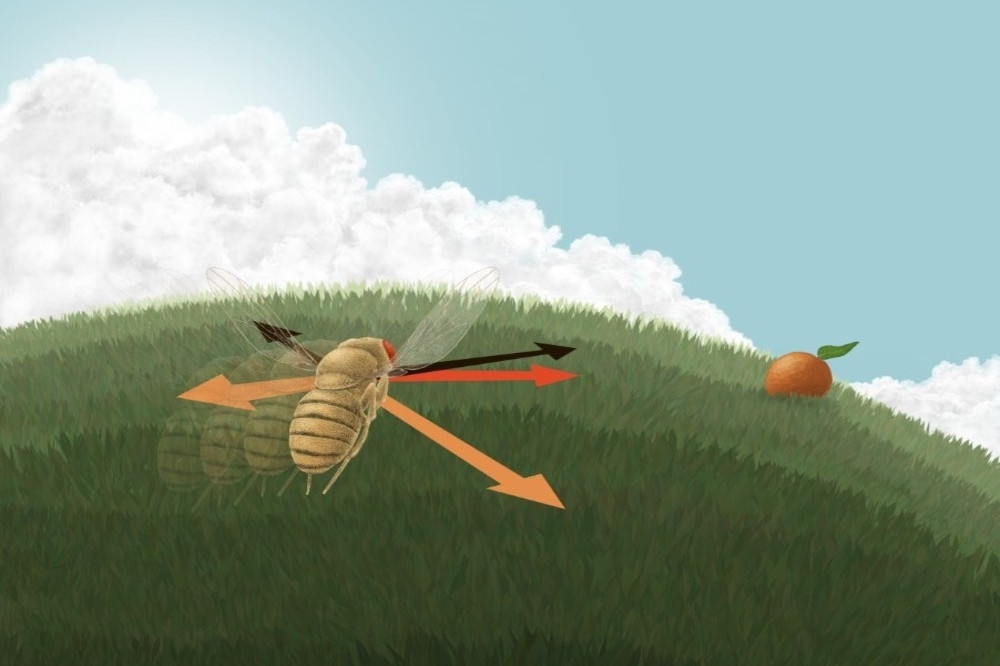 Close-up of a fly in a miniature harness used in a Rockefeller University study to investigate how fly brains navigate. The research reveals flies use vector math for direction calculation.
Close-up of a fly in a miniature harness used in a Rockefeller University study to investigate how fly brains navigate. The research reveals flies use vector math for direction calculation.
Have you ever watched a fly seemingly unfazed by a gust of wind pushing it off course? These tiny creatures, like fish swimming upstream or crabs moving sideways, face a complex navigational challenge. Their heads might be pointing one way, but their bodies are traveling in another. For neuroscientists, understanding how the brain calculates direction of travel in such scenarios has been a long-standing puzzle.
Groundbreaking research from Rockefeller University has shed light on this mystery, revealing that the fly brain possesses a dedicated system of neurons that signal the direction of bodily movement, irrespective of head orientation. Published in Nature, the study details the intricate neural computations that enable flies to transform basic sensory information into a clear understanding of their travel direction.
“These neurons not only indicate the fly’s direction of travel, but they do so within a world-centered framework,” explains Gaby Maimon, a neuroscientist at Rockefeller University. Cheng Lyu, the study’s first author and a graduate student in the Maimon lab, highlights the remarkable nature of this process: flies convert sensory input related to their body into a signal that is referenced to the external world, allowing them to perceive their movement relative to fixed points like the sun. For instance, a fly can discern that it’s moving 90 degrees to the right of the sun, or directly northward.
The Internal Compass: Beyond Head Direction
Humans and animals alike possess an innate sense of spatial awareness. Even with our eyes closed, we generally maintain a good understanding of our location and orientation within a space. Scientists discovered in the 1980s that “head direction cells” play a crucial role in this internal mapping, signaling our angular orientation much like a compass. Flies, too, have similar cells.
These head-direction cells work seamlessly when movement aligns with head direction. They update our internal sense of position as we move forward in the direction we are facing. However, complications arise when head direction and travel direction diverge. Imagine walking north while facing east, or a fly attempting to fly forward against a headwind. In such cases, head-direction cells alone would provide misleading information. Yet, flies navigate windy conditions with surprising ease, and humans don’t become disoriented when glancing around. Lyu and Maimon questioned how flies maintain their sense of direction even when head-direction cells might be relaying seemingly inaccurate data.
To investigate this, Lyu devised an ingenious experimental setup. Fruit flies were delicately secured in miniature harnesses that stabilized their heads, allowing for brain activity recording while the flies were free to flap their wings and maneuver their bodies within a virtual reality environment. This environment included visual cues: a bright light simulating the sun and a field of dimmer dots that could be manipulated to create the sensation of being blown backward or sideways.
The results confirmed the expected behavior of head direction cells: they consistently indicated the fly’s orientation relative to the “sun,” regardless of the motion of the dimmer dots. Crucially, the researchers also identified a novel set of neurons. These cells didn’t track head direction; instead, they signaled the fly’s actual direction of travel. For example, if a fly was facing east towards the “sun” but the visual dots indicated it was being pushed westward, these new cells accurately signaled westward movement. “This is the first known group of cells to indicate an animal’s direction of movement in a world-centered reference frame,” Maimon emphasizes.
Vector Math in Miniature Brains: Neural Trajectory Calculation
Beyond identifying these crucial neurons, the team sought to understand the computational mechanisms within the fly brain that determine travel direction. In collaboration with Larry Abbott, a theoretical neuroscientist at Columbia University’s Zuckerman Institute, Lyu and Maimon discovered that the fly brain engages in a form of mathematical processing akin to vector mathematics.
In physics, analyzing motion often involves breaking down trajectories into components along x- and y-axes. Similarly, the fly brain utilizes four classes of neurons sensitive to visual motion. These neurons represent the fly’s travel direction as components across four axes. Each neuronal class functions like a mathematical vector: its angle representing direction and its length representing speed along that direction.
“Remarkably, a neural circuit in the fly brain rotates these four vectors to correctly align them with the sun’s angle and then sums them,” Maimon explains. “The outcome is a resultant vector that points in the direction the fly is traveling, referenced to the sun.”
This isn’t just a metaphorical analogy; the fly brain appears to be literally performing vector operations. Within this circuit, neuron populations represent vectors as waves of activity. The wave’s position encodes the vector’s angle, and its amplitude reflects the vector’s length. The researchers rigorously tested this concept by precisely manipulating the lengths of the four input vectors and observing that the output vector changed precisely as predicted by vector addition.
“We present strong evidence that the fly brain is implementing vector math explicitly,” Maimon states. “This study is unique in demonstrating, with extensive proof, how neuronal circuits execute relatively complex mathematical operations.”
Implications for Spatial Understanding and Beyond
This research illuminates how flies instantaneously determine their direction of travel. Future studies will delve into how these insects track their travel direction over time to build a cumulative understanding of their location and journey. “A key question is how the brain integrates signals related to travel direction and speed over time to form spatial memories,” says Lyu. “Our findings can serve as a foundation for investigating working memory mechanisms in the brain.”
Furthermore, these discoveries may hold relevance for understanding human neurological conditions. Spatial disorientation is often an early symptom of Alzheimer’s disease, making the brain’s spatial processing mechanisms a critical area of research. “The fact that insects, with their remarkably small brains, possess explicit knowledge of their travel direction should motivate researchers to search for similar signals and analogous quantitative operations in mammalian brains,” Maimon suggests.
“Such findings could provide insights into the dysfunctions underlying Alzheimer’s disease and other neurological disorders affecting spatial cognition.”
